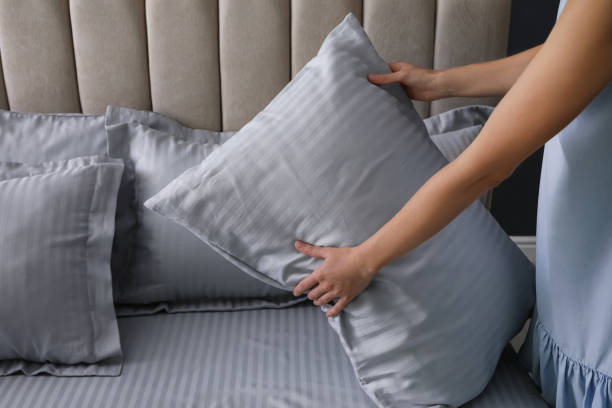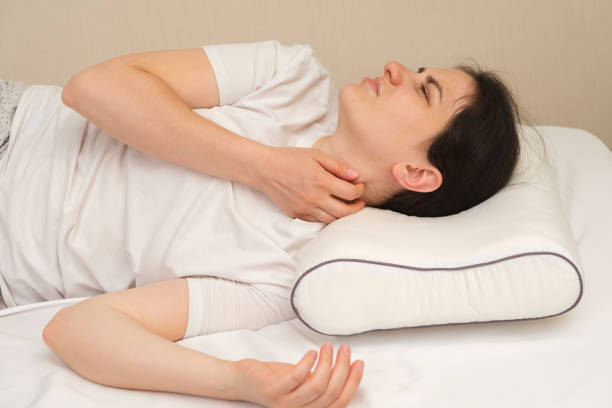Introduction

Do you experience back pain that makes it difficult to find a comfortable sleeping position? If so, you're not the only one. Back pain can disrupt your sleep and leave you feeling exhausted and frustrated. However, a simple and effective solution is at your fingertips - pillows! This blog will explore using pillows strategically to achieve better sleep and alleviate back pain. Pillows are more than just fluffy accessories; they can be powerful tools in optimizing your sleep posture and supporting your aching back.
Whether you're dealing with upper back pain, lower back pain, or even sciatica, we've got you covered. Get ready to transform your sleep experience and wake up refreshed and pain-free. Come learn how to position pillows for better sleep, especially if you're experiencing back pain. Join us for an exciting dive into this world!
Understanding Back Pain and Sleep
Back pain can have various causes, including muscle strains, herniated discs, arthritis, and poor posture. Finding a comfortable sleeping position can be difficult when you experience stiffness and discomfort. Moreover, back pain often intensifies at night due to increased pressure on the spine. This can result in sleep disturbances, restlessness, and waking up feeling unrefreshed.
Using the right pillow can alleviate these issues and promote better sleep. A well-designed pillow helps maintain proper spinal alignment, reducing strain on the back muscles and allowing for a more comfortable sleep experience.
Choosing the Right Pillow for Back Pain
Regarding pillows for back pain, one size does not fit all. The ideal pillow will depend on personal preferences, sleeping position, and the severity of back pain. Choosing a pillow that offers proper support and aligns the head, neck, and spine in a neutral position is crucial.
Several types of pillows are beneficial for individuals with back pain. Memory foam pillows are specially designed to adjust and fit the contours of your head and neck, providing tailored support. Latex pillows offer a balance of softness and support, promoting spinal alignment. Adjustable pillows allow you to customize the loft and firmness according to your needs.
Considerations for selecting the right pillow include firmness, height, and materials used. It's advisable to test different pillows or seek guidance from a healthcare professional to find the most suitable option for your specific needs.
Here are some types of pillows that can be beneficial for individuals with back pain:
1: Supportive Pillows
Supportive pillows provide extra support to different parts of your body, including your back. These pillows are commonly made of materials such as memory foam or latex that conform to the shape of your body. They help alleviate pressure points and maintain spinal alignment, promoting better sleep and reducing back pain.
2: Adjustable Pillows
Adjustable pillows allow you to customize their loft and firmness according to your needs. These pillows typically come with removable inserts or layers that can be adjusted to achieve the desired level of support. With an adjustable pillow, you can experiment with different configurations to find the most comfortable position for your back.
3: Orthopedic Pillows
Orthopedic pillows are specially designed to support the natural curves of your spine. They provide targeted neck, shoulders, and lower back support. These pillows help maintain proper spinal alignment and relieve pressure, benefiting individuals with back pain.
4: Body Pillows
Body pillows are elongated pillows that support your entire body, from head to toe. They are particularly useful for individuals who prefer sleeping on their sides. Body pillows promote proper spine alignment and offer full-body support, reducing strain on the back and alleviating pain.
5: Memory Foam Pillows
Memory foam pillows are created to match the individual shape of your head and neck to provide customized support. They distribute your body weight evenly, reducing pressure on your back. Memory foam pillows also absorb movement, ensuring minimal disturbance during sleep.
6: Cooling Pillows
Cooling pillows regulate body temperature and keep you cool throughout the night. Excessive heat can exacerbate back pain and disrupt sleep. Cooling pillows use materials that dissipate heat, ensuring a comfortable and soothing sleep environment.
7: Water Pillows
Water pillows contain a water-filled chamber that adjusts to your head and neck movements. These pillows provide excellent support and conform to your body shape, reducing strain on your back. Water pillows also allow you to customize the firmness by adjusting the water level.
8: Buckwheat Pillows
Buckwheat pillows contain buckwheat hulls that offer firm and customizable support. These pillows conform to your body shape while allowing air circulation, keeping you cool. Buckwheat pillows are known for their durability and ability to alleviate back pain.
9: Sleep Position Adjustment
In addition to using the right pillows, adjusting your sleep position can help reduce back pain. Consider using a pillow to support your sleeping position to alleviate back pain.
You can use a pillow to rest your knees to maintain the natural curve of your spine while sleeping on your back. Additionally, if you prefer sleeping on the side, putting a pillow between your knees can align your hips and decrease the stress on your lower back. Try different sleeping positions to find the one that suits you the best.
10: Additional Sleep Aids
Besides pillows, other sleep aids can improve sleep quality and alleviate back pain. Some options include mattress toppers, mattress pads, adjustable beds, and heating pads. To determine if these extra tools suit your specific requirements, consult your healthcare provider.
Pillow Placement for Different Sleeping Positions

The optimal pillow placement varies depending on your preferred sleeping position. Here are some recommendations for each position:
-
Sleeping on the back: Choose a pillow that supports the neck's natural curve and keeps the head aligned with the spine. A pillow with medium firmness and a slight contour can be beneficial.
-
Sleeping on the side: To support your head and shoulder more, use a thicker pillow to fill the gap between them. This helps maintain a neutral spine alignment. Consider a pillow with medium to firm support.
-
Sleeping on the stomach: Sleeping on the stomach is generally not recommended for individuals with back pain as it can strain the neck and spine. However, if you prefer this position, use a thin or no pillow to minimize strain.
Additional Tips for Better Sleep with Back Pain

In addition to using the right pillow, there are other strategies you can implement to improve sleep quality with back pain:
-
Maintain a comfortable sleep environment: Ensure your mattress provides adequate support and is suitable for your back condition. Use breathable bedding materials and keep the room temperature cool and comfortable.
-
Practice good sleep hygiene: To improve the quality of your sleep, it is recommended to keep a regular sleep schedule, follow a relaxing bedtime routine, and refrain from using electronic devices before going to bed. A dark, quiet, calm sleep environment can promote better sleep quality.
-
Incorporate gentle stretching and relaxation techniques: Try doing some yoga, stretching, or deep breathing exercises before bed to help your muscles relax and release tension in your back.
Seeking Professional Advice
If your back pain persists or worsens despite using appropriate pillows and adopting good sleep practices, it's important to seek professional advice. A healthcare professional or therapist specializing in back pain can provide personalized guidance and recommend additional treatments or therapies that may benefit your condition. Physical therapy or chiropractic care can be particularly beneficial in managing back pain and improving sleep quality.
Where do you put pillows when sleeping with back pain?
The best way to use pillows for better sleep with back pain is to provide support and comfort while reducing pressure on the lower back. When sleeping on your side, place a pillow between your knees to slightly elevate the top leg and prevent your hips from rolling outward. This will reduce strain on your spine and help promote proper alignment. Try putting a pillow under your knees to reduce tension in your lower back while sleeping. Adding an extra pillow under your head and neck can also be helpful for more comfort.
Can I use the pillow if I have back pain?
Yes, a pillow can help improve sleep quality and reduce back pain in many people. Choosing a pillow that is comfortable and supportive for your sleeping position is important. For better sleep, maintain a regular sleep schedule, follow a relaxing bedtime routine, and refrain from using electronic devices before bedtime. Thinner pillows may be more comfortable for those who sleep on their back. Make sure to adjust the height and firmness of your pillow until you find what works best for you.
Additionally, many memory foam pillows are designed to provide a tailored support system that helps keep the spine in proper alignment while sleeping. If these don't work, specific therapeutic pillows can also be adapted to support your back and neck. Depending on any existing medical conditions, consulting with a doctor may help identify the right pillow for you. Finding the right pillow to comfort and relieve back pain is important.
Conclusion
I hope this article has provided a better understanding of how pillows can enhance sleep quality, particularly when experiencing back pain. Selecting a comfortable and supportive pillow and implementing good sleep hygiene practices are crucial. If you're still struggling with persistent back pain or discomfort during the night, seeking professional advice from a healthcare provider may be beneficial. Improving the quality of your sleep and reducing back pain is possible by utilizing the appropriate pillow and following proper sleep habits.
FAQ's
Should you sleep with a pillow if you have lower back pain?
Yes, sleeping with a pillow can provide support and comfort to reduce pressure on the lower back. To find a comfortable and supportive pillow, it's important to consider your preferred sleeping position and experiment with both thicker and thinner options based on your individual needs.
How do you properly use a pillow?
The correct way to use a pillow may vary depending on your sleeping position. For instance, placing a pillow between your knees might be helpful if you sleep on your side. This can help keep your hips aligned and reduce strain on your spine. Placing a pillow under the knees can support the lower back and reduce pressure if you sleep on your back.
What is the fastest way to relieve back pain at home?
The fastest way to relieve back pain at home is to practice good posture and use heat or cold therapy. Movement may also help reduce stiffness and tension in the back muscles. Additionally, using a pillow for support, such as memory foam or therapeutic pillows, can help improve sleep quality and relieve back pain.
What is the correct way to sleep?
The correct way to sleep will depend on individual preferences and medical conditions. Generally, sleeping on your side with a pillow between the knees is considered the best position for those suffering back pain. Placing a pillow under your knees while sleeping on your back can reduce pressure and ensure your spine is properly aligned. Experimenting with different positions is important until you find what works best.
How many pillows should you sleep with back pain?
For people with back pain, the ideal number of pillows to sleep with can vary. Generally, it's best to start with one pillow placed between your knees if you are sleeping on your side or under the knees if you are sleeping on your back. Adding a second pillow under your head and neck may be helpful for additional comfort. Experiment with the height and firmness of the pillow until you find what works best for your back pain.
How do you get rid of lower back pain permanently?
If you are experiencing lower back pain, managing it can be challenging, and getting medical assistance may be required. Nonetheless, some people discover that consistent exercising, maintaining good posture, and employing a pillow for support can aid in slowly decreasing the intensity of their lower back pain. If your condition continues, it's best to consult a medical practitioner for the most appropriate next steps.

